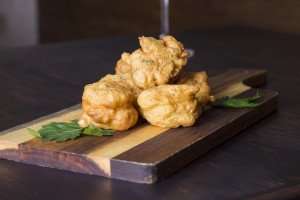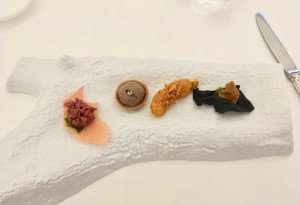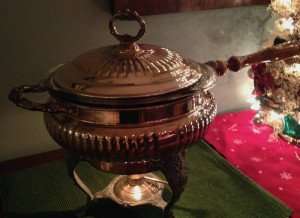Top Food and Drink Trends for Summer
June 14, 2024
There are very few activities we find more exciting or interesting than trying new foods and cooking our favorite innovations at home. Summer is…
Read This Post As we approach the holidays, one thing everyone seems to be looking for are appetizer recipes. Whether for a sit-down meal or as a spread of munchies to sustain you through the day, there is no doubt that appetizers are a big part of holiday meal planning. And certainly at The International Kitchen when we get together for holiday parties, potlucks, or birthday celebrations, appetizers are always a key part of the meal.
As we approach the holidays, one thing everyone seems to be looking for are appetizer recipes. Whether for a sit-down meal or as a spread of munchies to sustain you through the day, there is no doubt that appetizers are a big part of holiday meal planning. And certainly at The International Kitchen when we get together for holiday parties, potlucks, or birthday celebrations, appetizers are always a key part of the meal.
So what defines an appetizer? Do they exist everywhere? What’s the difference between an hors d’oeuvre and an antipasto? Between aperitivos and tapas? Canapés and crudités? A starter and an entrada? An amuse-gueule and an amuse-bouche?
Jump to our recipe for cocktail meatballs.
 The Origins of Appetizers
The Origins of AppetizersThe fact that there are so many different names for what is basically the same thing tells us that appetizers are an extremely popular culinary concept. There are different theories as to where the custom of appetizers started. I’ve read they go back to the ancient Athenians and the ancient Romans, but I’ve also read that their origin lies in Russia, China, and Scandinavia.
It seems, frankly, an exercise in futility to me to determine the origin. We are basically talking about a little bite of food to satisfy you until it’s time to eat. Surely even back in the hunter-gatherer days, people put out a dish of nuts to keep the guests at bay while the meat roasted?
 Read about pairing wines with appetizers.
Read about pairing wines with appetizers.
So what is the answer to our prior question: what is the difference between all these terms? Read on for The International Kitchen’s glossary on appetizer terminology!
Amuse-bouche: a small hors d’oeuvre that can be eaten in a single bite and is usually not ordered, but rather offered for free and made at the whim of the chef. The term literally means “mouth amuser.” An alternate term is amuse-gueule (gueule also means mouth or snout).
Antipasto: the Italian word for an appetizer, it means literally “before the meal.” In the US “antipasti” has come to mean more frequently a specific set of Italian products (usually Italian cold cuts, cheeses, olives, and pickled/cured vegetables), but “antipasti” really is just the plural form of antipasto and can refer to any appetizer.
 Antojito: in Mexico, the word literally means “little cravings” or “little desires,” it is a generic word for the snacks that are traditionally served as street food (tacos, sopes, huaraches, etc., can all be antojitos).
Antojito: in Mexico, the word literally means “little cravings” or “little desires,” it is a generic word for the snacks that are traditionally served as street food (tacos, sopes, huaraches, etc., can all be antojitos).
Apéritif/Aperitvo: although many know that an apéritif is an alcoholic beverage enjoyed before the meal (and meant to stimulate the appetite), it can also refer to the snacks that accompany the drinks. These are usually very small (even as small as a bowl of nuts or olives), and don’t require plates or cutlery. Think of it as a catch-all word for a cocktail hour with snacks.
Appetizer: as the name suggests, this is a small plate that is meant to stimulate the appetite before the main meal.
 Canapé: a specific type of hors d’oeuvre, these traditionally have 3 components: bottom, middle, and garnish, and are eaten by hand in one or two bites. The name comes from the French word for sofa since the toppings “sit” atop the bread or cracker that holds them. A classic example is a cracker with a bit of cheese and sliced fruits. A vol-au-vent is a type of canapé made with puff pastry.
Canapé: a specific type of hors d’oeuvre, these traditionally have 3 components: bottom, middle, and garnish, and are eaten by hand in one or two bites. The name comes from the French word for sofa since the toppings “sit” atop the bread or cracker that holds them. A classic example is a cracker with a bit of cheese and sliced fruits. A vol-au-vent is a type of canapé made with puff pastry.
Check out our Paris cooking classes and our France cooking vacations.
Cichetti (alternate variations cicchetti, cicheti): a very specific term for a type of bar food in Venice, much like tapas, but they are traditionally eaten standing up in local bàcari, or taverns.
 Crostini: a type of Italian canapé, these are slices of bread, usually toasted, and topped with some topping. A bruschetta is basically a more specific type of crostino, namely one that has been grilled on both sides and drizzled with some combination of olive oil, salt, garlic, fresh tomato, and basil. A crostino can be topped with almost anything and is usually served on a smaller, more fine-textured slice of bread.
Crostini: a type of Italian canapé, these are slices of bread, usually toasted, and topped with some topping. A bruschetta is basically a more specific type of crostino, namely one that has been grilled on both sides and drizzled with some combination of olive oil, salt, garlic, fresh tomato, and basil. A crostino can be topped with almost anything and is usually served on a smaller, more fine-textured slice of bread.
Crudité: a specific type of appetizer, these are raw vegetables served whole or sliced with a dipping sauce (usually a basic vinaigrette). In Italy, they are called a pinzimonio, and in Piedmont are served with a wonderful hot, anchovy, and garlic-based dipping sauce called bagna cauda. In Provence, it is often served with an anchoiade.
 Hors d’oeuvre: literally “outside the work” (meant in the sense of outside the main meal), these were originally small, one-bite morsels, usually eaten by hand. Although they can also be served between courses, they are now usually understood to precede the meal.
Hors d’oeuvre: literally “outside the work” (meant in the sense of outside the main meal), these were originally small, one-bite morsels, usually eaten by hand. Although they can also be served between courses, they are now usually understood to precede the meal.
Try making gougères, or choux pastry puffs.
Mezze (or meze): in Middle Eastern cuisine these are small plates a bit like tapas. They can be served as single appetizers, but are often served as mezze platters and shared.
Pintxo: a word for a specific type of tapas that hails from the Basque country, they are usually served atop a piece of bread and affixed with a skewer (pintxo or pincho).
Learn to make Pinxtos in the Basque Country on our fabulous Bilbao Spain culinary vacation.
 Starter/Entreé/Entrada: basically another name for an appetizer, it is a bit of food that starts the meal, but is not part of the main meal itself. In some countries, this might be as small as a dish of olives or nuts, or it can be a more composed appetizer (and larger than an hors d’oeuvre). Note that although in the U.S. “entree” means the main dish, in France it means starter (or “entrance” to the meal). In Portugal, these entradas are often brought to the table as a matter of course (along with a basket of bread), but that does not mean you won’t be charged for them (don’t worry though, they don’t add much to the bill!).
Starter/Entreé/Entrada: basically another name for an appetizer, it is a bit of food that starts the meal, but is not part of the main meal itself. In some countries, this might be as small as a dish of olives or nuts, or it can be a more composed appetizer (and larger than an hors d’oeuvre). Note that although in the U.S. “entree” means the main dish, in France it means starter (or “entrance” to the meal). In Portugal, these entradas are often brought to the table as a matter of course (along with a basket of bread), but that does not mean you won’t be charged for them (don’t worry though, they don’t add much to the bill!).
Learn more about traveling in Portugal and check out our Portugal culinary tours.
 Tapas: in Spain, these are small plates of food, either hot or cold. Originally they were served in bars to accompany drinks, and “tapa” (“lid” or “cover”) refers to the fact that they were placed on top of the glass. Although they used to be, and sometimes still are, free (think of a salty bowl of peanuts meant to encourage you to drink more!), now there is usually a charge for them. It is also now common practice to turn them into a full meal by ordering several different tapas.
Tapas: in Spain, these are small plates of food, either hot or cold. Originally they were served in bars to accompany drinks, and “tapa” (“lid” or “cover”) refers to the fact that they were placed on top of the glass. Although they used to be, and sometimes still are, free (think of a salty bowl of peanuts meant to encourage you to drink more!), now there is usually a charge for them. It is also now common practice to turn them into a full meal by ordering several different tapas.
Read about different types of tapas and learn to make tapas on a Spain cooking vacation.
Of course, we have not even touched on appetizers in many other countries!
 There are so many appetizers in our recipe archives you could easily find enough for the entire holiday season. But here are some of our favorites:
There are so many appetizers in our recipe archives you could easily find enough for the entire holiday season. But here are some of our favorites:
Spring Rolls
Gravlax
Salt Cod Fritters
Empanadas
Octopus Salad
Baba Ganoush
Pita and Hummus
Spanakopita
Tortilla Española
Eggplant Caponata
Sarde in Saor
Tuscan Bean Dip
Tapenade
Spiced Olives
Gambas Pil Pil
Four Cheese Filo Parcels
Bruscehtte al Pomodoro e Basilico
Arantcini di Risu
And if you’d like to try something else, how about…
 Cocktail Meatballs
Cocktail MeatballsThis is an adaptation of an old family recipe for cocktail meatballs, but I suspect it hails originally from a Betty Crocker cookbook, or perhaps an old church cookbook. Regardless, it remains a favorite. We have several gluten- and dairy-free people in our family, and while I wouldn’t call this recipe healthy, it is gluten and dairy-free!
The original recipe calls for cooking the meatballs in the sauce, but I find that it makes the sauce too greasy. The original recipe also calls for bottled chili sauce, but I learned long ago to whip up my own when I didn’t have any on hand. If you want to skip this step, just use the bottled stuff instead of the first nine sauce ingredients. The grape jelly might sound strange, but it’s a key ingredient!
 I have fond memories of Christmas Eve appetizer spreads featuring these meatballs in my mom’s silver chafing dish. (I was frequently the one charged with polishing it for its once-a-year use!) When my mom decided she didn’t want it taking up space anymore, I was happy to take it off her hands, and now I use it for my own holiday appetizer spreads.
I have fond memories of Christmas Eve appetizer spreads featuring these meatballs in my mom’s silver chafing dish. (I was frequently the one charged with polishing it for its once-a-year use!) When my mom decided she didn’t want it taking up space anymore, I was happy to take it off her hands, and now I use it for my own holiday appetizer spreads.
Enjoy!
Serves: 12
Prep time: 10 minutes
Cook time: 25 minutes
Cook method: Bake, Simmer

1. Preheat oven to 400F.
2. Mix the ingredients for the meatballs in a large bowl, then form them into small meatballs. (Make sure they are not too big.)
3. Place on a baking sheet covered with a wire rack (if you line the baking sheet with aluminum foil cleanup will be easier). Bake for 20 minutes, then remove from the oven.
4. In the meantime, mix the sauce ingredients together and simmer over low heat for 5-10 minutes, until the flavors combine.
5. Add the meatballs and simmer together for 5 minutes.
 Do you have favorite holiday appetizer recipes from your childhood?
Do you have favorite holiday appetizer recipes from your childhood?
By Peg Kern
Sign up to receive our newsletter, which includes travel tips, recipes, promotions, and information on our best culinary tours.
Find more photos, videos, food facts, and travel stories from The International Kitchen on Facebook, Instagram, Pinterest, Twitter, and YouTube.